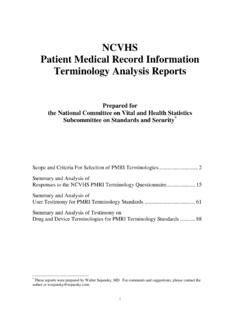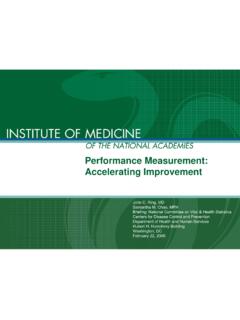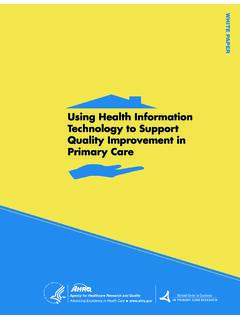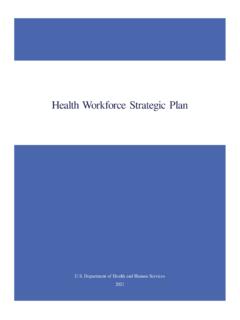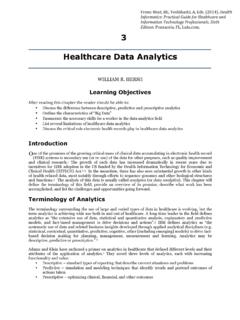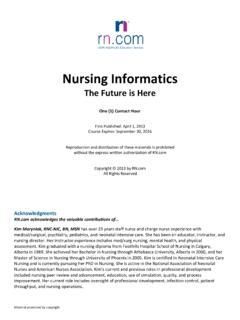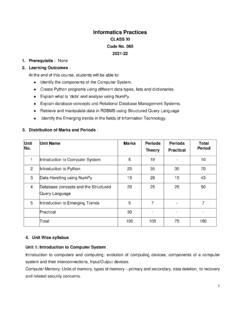Transcription of Healthcare Terminologies Classifications
1 HealthcareTerminologies andClassifications:An Action Agenda for the United StatesAmerican Medical informatics Association and American health Information Management Association Terminology and Classification Policy Task Force AHIMA and AMIA Terminology andClassification Policy Task Force MembersKeith , MD, PhD Chair,AHIMA and AMIA Terminologies and Classifications Policy Task ForceChief Technology Officer, informatics , Inc.,and Assistant Clinical Professor;Department of Medical informatics and Clinical Epidemiology, Oregon health andScience UniversitySuzanne Bakken,RN, DNSc, FAAN Alumni Professor of Nursing and Professor of Biomedical informatics School ofNursing and Department of Medical informatics , Columbia UniversitySue Bowman, RHIA, CCS Director of Coding Policy and Compliance, American health InformationManagement AssociationChristopher Chute,MD, PhD Professor and Chair of Biomedical informatics , Mayo FoundationDon Detmer, MD,MA President and Chief Executive Officer.
2 American Medical informatics AssociationJennifer Hornung Garvin, PhD, RHIA, CPHQ, CCS, CTR, FAHIMA Medical informatics Postdoctoral Fellow Center for health Equity Research andPromotion, Philadelphia Veterans Administration Medical CenterKathy Giannangelo, MA, RHIA, CCS,CPHIMS Director, Practice Leadership,AHIMA Gail Graham,RHIA Director, health Data and informatics Department of Veterans AffairsStanley ,MD Professor of Medical informatics , University of Utah Senior Medical Informaticist,Intermountain HealthcareLinda Kloss,MA, RHIA, FAHIMA Chief Executive Officer,AHIMA Margaret Skurka, MS, RHIA, CCS Professor and Director of health Information Programs, Indiana University Northwest Mary Stanfill, RHIA, CCS, CCS-P Vice President, Practice Resources, AHIMAV alerie Watzlaf, PhD, RHIA, FAHIMAA ssociate Professor, Department of health Information Management, School ofHealth and Rehabilitation Sciences,University of PittsburghThe American HealthInformation ManagementAssociation (AHIMA) is the premier association ofhealthinformation management(HIM)
3 S51,000 members are dedicated tothe effective management ofpersonal health informationneeded to deliver qualityhealthcare to the in 1928 to improve thequality ofmedical records,AHIMA is committed toadvancing the HIM profession inan increasingly electronic andglobal environment throughleadership in advocacy,education, certification,andlifelong learning. To learn more,go to American MedicalInformatics Association (AMIA)is the premier organization inthe United States dedicated tothe development and applicationofmedical informatics in thesupport ofpatient care,teaching,research,and linksdevelopers and users ofhealthinformation technology, creatingan environment which fostersadvances that revolutionizehealthcare.
4 To learn more,go of ContentsExecutive Summary ..4 Background ..5 Magnitude of the Problem ..7 The Vision and Goals for the US ..9 What to Do Next ..15 Role of AHIMA and AMIA ..18 Conclusion ..19 Table 1:Governance of Various Terminology Systems ..20 Table 2:Development and Maintenance of Various Terminology Systems ..23 Appendix A:Australia,the United Kingdom,and Canada ..27 Appendix B:Terminology Services and Tools ..29 Table 3:Terminology Services and Tools in Four Organizations ..30 Glossary ..32 This white paper is a revised version ofa paper originally released by AHIMA and AMIA in 2006.
5 20073 Healthcare Terminologies and Classifications : An Action Agenda for the United StatesExecutive SummaryTerminologies and Classifications form thefoundations of information content in theelectronic health record (EHR) and are thebasis for research,public health reporting, andhealthcare are integral tointeroperability and,thus,a successful nationalhealth information system that promisesincreased patient safety and reduced there has been significant progress inthe United States to better understand the roleterminologies play in our health informationsystems,and to make Terminologies morebroadly available in machinable forms, moremust be done to ensure that this progressserves as a robust foundation for theinformation content of the Healthcare industry including thegovernment.
6 Professional organizations,publicand private institutions,and health informaticsand information management professionals must address the issues before the UShealthcare system is marginalized. To not do sowould mean continued reliance on poor-quality data for decision making and thespending of dollars to retrofit a system that isobviously report describes challenges that requireaction. It proposes the formation of acentralized terminology authority, and othersteps, to address these Force Vision andRecommendationsThe American Medical informatics Association(AMIA) and the American health InformationManagement Association (AHIMA) are pleasedwith the progress made thus far and arecommitted to the development of the emergingnational health information system.
7 But bothorganizations recognize that additionalresources and appropriate funding are neededto build on initial work for healthcareterminologies and Classifications strategy,governance,and development andmaintenance address these issues,AHIMA and AMIA convened a Terminology and ClassificationPolicy Task Force composed of experts inmedical and nursing informatics (a field thatstudies the support of medicine by informationsystems), health information managementprofessionals, experts in nosology (the branchofmedicine that deals with the classification ofdiseases),and educators.
8 The group s goal wasto develop recommendations for the majorchallenges that would help establish a processthat results in interoperability. The Task Forcehas formulated a vision and associated goalsand recommendations that it hopes will beused to frame a public-private dialogue abouthow to redesign the US approach to healthcareterminologies and Classifications against abackdrop of international approaches vision consists of the following: US governance occurs from a nationalperspective against a backdrop ofinternational agendas. US policy coordinates with othercountries,and the US actively collaboratesand shares costs.
9 Coordination and collaboration occurswith international terminology andclassification development andmaintenance Terminologies and Classifications : An Action Agenda for the United States1. For purposes of this report, an EHR is defined as an information system designed to provide access to complete andaccurate clinical data, practitioner alerts and reminders, clinical decision support systems, and links to medical , K. (Ed). Healthcare Code Sets, Clinical Terminologies , and Classification Systems. AHIMA. [Note: Within thisdefinition, a personal health record (PHR) only qualifies as an EHR if it is part of an EHR having the identified capabilities.]
10 ] Terminologies , Classifications ,and mapsform a coherent set of policies andprocedures for openness and ensuredperformance. Transparency of process exists even whenthe development organization maintainsthe system within its own organization. Infrastructure for development andmaintenance ofthe terminology is subjectto an open process. Business process automation isimplemented, allowing organizations toparticipate and track the terminology andclassification development processes,reducing cost, and automating manyaspects ofthe system release implement this vision,the Task Forcerecommends that the Healthcare industry government, public and private institutions,and professional organizations collaboratively undertake the following tasks: Create a publicly funded research anddevelopment project to preparespecifications for coordinated solutionsand where possible,consolidateterminology.
